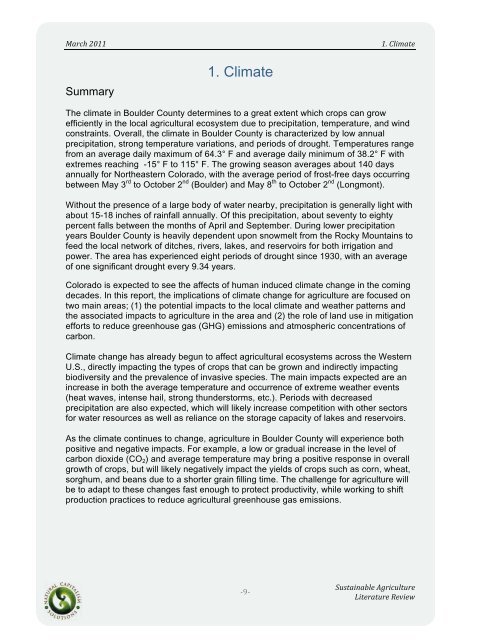Sustainable Agriculture Literature Review - Boulder County
Sustainable Agriculture Literature Review - Boulder County
Sustainable Agriculture Literature Review - Boulder County
Create successful ePaper yourself
Turn your PDF publications into a flip-book with our unique Google optimized e-Paper software.
! ! !!<br />
"#$%&!'())! !!!!!!!!!!!!!!!!!!!!!!!!!!!!!!!!!!!!!!!!!!!!!!!!!! )=!>1.;#-2!<br />
Summary<br />
!<br />
1. Climate<br />
The climate in <strong>Boulder</strong> <strong>County</strong> determines to a great extent which crops can grow<br />
efficiently in the local agricultural ecosystem due to precipitation, temperature, and wind<br />
constraints. Overall, the climate in <strong>Boulder</strong> <strong>County</strong> is characterized by low annual<br />
precipitation, strong temperature variations, and periods of drought. Temperatures range<br />
from an average daily maximum of 64.3° F and average daily minimum of 38.2° F with<br />
extremes reaching -15° F to 115° F. The growing season averages about 140 days<br />
annually for Northeastern Colorado, with the average period of frost-free days occurring<br />
between May 3 rd to October 2 nd (<strong>Boulder</strong>) and May 8 th to October 2 nd (Longmont).<br />
Without the presence of a large body of water nearby, precipitation is generally light with<br />
about 15-18 inches of rainfall annually. Of this precipitation, about seventy to eighty<br />
percent falls between the months of April and September. During lower precipitation<br />
years <strong>Boulder</strong> <strong>County</strong> is heavily dependent upon snowmelt from the Rocky Mountains to<br />
feed the local network of ditches, rivers, lakes, and reservoirs for both irrigation and<br />
power. The area has experienced eight periods of drought since 1930, with an average<br />
of one significant drought every 9.34 years.<br />
!<br />
Colorado is expected to see the affects of human induced climate change in the coming<br />
decades. In this report, the implications of climate change for agriculture are focused on<br />
two main areas; (1) the potential impacts to the local climate and weather patterns and<br />
the associated impacts to agriculture in the area and (2) the role of land use in mitigation<br />
efforts to reduce greenhouse gas (GHG) emissions and atmospheric concentrations of<br />
carbon.<br />
Climate change has already begun to affect agricultural ecosystems across the Western<br />
U.S., directly impacting the types of crops that can be grown and indirectly impacting<br />
biodiversity and the prevalence of invasive species. The main impacts expected are an<br />
increase in both the average temperature and occurrence of extreme weather events<br />
(heat waves, intense hail, strong thunderstorms, etc.). Periods with decreased<br />
precipitation are also expected, which will likely increase competition with other sectors<br />
for water resources as well as reliance on the storage capacity of lakes and reservoirs.<br />
As the climate continues to change, agriculture in <strong>Boulder</strong> <strong>County</strong> will experience both<br />
positive and negative impacts. For example, a low or gradual increase in the level of<br />
carbon dioxide (CO2) and average temperature may bring a positive response in overall<br />
growth of crops, but will likely negatively impact the yields of crops such as corn, wheat,<br />
sorghum, and beans due to a shorter grain filling time. The challenge for agriculture will<br />
be to adapt to these changes fast enough to protect productivity, while working to shift<br />
production practices to reduce agricultural greenhouse gas emissions.<br />
"*"<br />
!*+,-#./#012!34$.%+1-+$2!<br />
5.-2$#-+$2!627.28!
















